- Best Starter Skateboards: Which is Right for Your Needs? - April 12, 2021
- Best Longboards for Cruising: How to Find The Right One - March 30, 2021
- Best Longboard Bearings: Top 10 Options - March 21, 2021
To the uninitiated, skateboarding and longboarding may seem like essentially the same thing, and in essence, they are. But if you take a closer look, apart from the fact that you are riding a wooden board on wheels, they are, in practice, very different. From the style of riding to the boards being used, skateboarding and longboarding are drastically different, although they are branches of the same tree.
With this in mind, choosing a skateboard over a longboard or vice versa largely depends on what you want to do: are you just into surfing the streets, or do you want to perform complicated tricks?
In this article, we’ll go in-depth with the details of both skateboards and longboards and their different uses to help you choose the right board (and riding style) to suit your unique needs. Let’s get started!
Aesthetically and functionally, skateboards and longboards are completely different, from the way they are ridden to the hardware they comprise of. Here are some of the central differences between the two:
Main differences between Skateboard vs Longboard
The main differences between Skateboard vs Longboard are:
- Skateboards are short and narrow, whereas longboards are (as the name suggests) wide and long
- Skateboards have “kicks” on the nose and tail, whereas longboards typically have no kicks
- Skateboards have small, fast-accelerating wheels, whereas longboards have large, slow-accelerating but faster overall wheels
- Skateboards have a short wheelbase (the length between the trucks and wheels), whereas longboards have a varied, but long wheelbase
- Skateboards have symmetrical, “popsicle” shape, whereas longboards are typically asymmetrical
These are the most obvious and distinctive differences between skateboards and longboards, but as we’ll see below, there are several other important distinctions to be made too. To further put the differences between these boards in context, let’s have a little history lesson.
The origins of skateboarding
Skateboarding began as an alternative to surfing — on days when waves were flat or non-existent, surfers wanted a way to practice and decided to put some wheels on wooden planks, and likely even surfboards at first, to make the most of these flat days.
Of course, these first skateboarders quickly realized that these early prototypes were far too big and difficult to maneuver, and gradually shortened and redesigned the boards into the boards we see today. Since the ‘50s there has been a constant evolution of skateboards, and it was only in the mid-90s that the boards we use today were somewhat finalized.
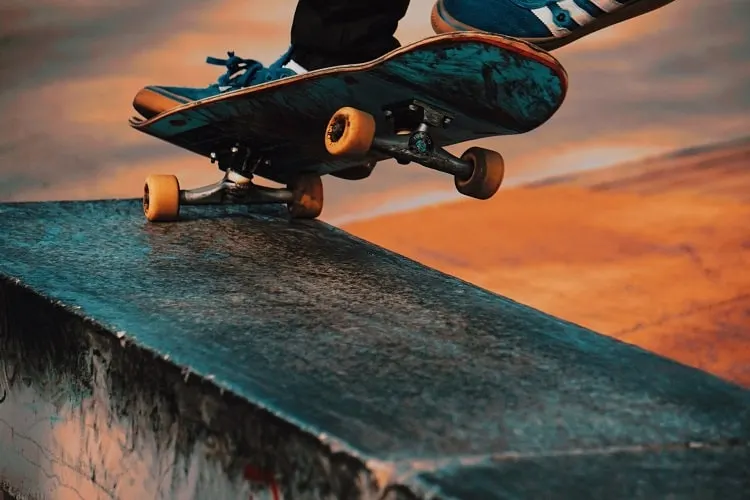
Ironically, skateboarding took off in popularity as a sport all on its own, and the sport continues to inspire and change surfing, the very sport it was created from. Skateboarders and surfers continually cross over and take tricks from the streets and apply them to waves, performing tricks on surfboards that were likely thought impossible a few decades ago.
The origins of longboarding
Longboarding came a long time after street skating and has only been gaining in popularity fairly recently. After the evolution of skateboards into smaller, more trick-worthy iterations, surfers realized that these new boards were far too small to cruise on, and again, evolution continued.
The board became long and flexible and far more reminiscent of surfboards again and were designed for cruising the streets or screaming downhills. The wheels got bigger, the trucks were redesigned, and the skateboard became the longboard we now see today.
The 5 main differences between skateboards and longboards
1. Size
The first thing you’ll notice if you put a skateboard and a longboard side by side is that they are vastly different in size. Longboards are far wider and longer than skateboards and for good reason. This extra length and width offer more stability and space for foot placement, making them far more suited for bombing hills at high speed.
Longboards are typically around 59-inches in length, although they can be a lot shorter too, and come in varying shapes. Skateboards, on the other hand, are around 36-inches at their longest, and have width variation of only an inch, beginning at 7.5-inches on the narrow end to 8.5-inches on the wider end.
2. Shape
Skateboards, in general, are all the same symmetrical “popsicle” shape, with a rounded nose and tail, varying depths of concave, and bent tails and noses called “kicks”. These kicks and concaves also help the board to “pop” and are maneuvered in the air, making it easy for skateboarders to perform tricks.
Longboards are generally completely flat, although some iterations have a small tail kick sometimes. They come in a massive variety of shapes, from surfboard-looking decks, “drop-through” decks, wheel cutouts, and hybrid shapes. Here are just a few of the most common longboard shapes:
- Pintail. A Pintail is a one-directional board, meaning it can only be ridden in one direction, unlike a popsicle board. These boards are wider in the center with a sharp nose and tail. Fish-tail boards are similar, but with a split tail similar to old surfboards.
- Dropdown. These boards feature a lower deck with raised noses and tails. They are great for beginners as they are very stable.
- Cruiser. Cruisers are smaller, shorter boards that resemble a skateboard and are ideal for beginners.
- Downhill. Made for speed, these boards come in several different shapes with one common objective: going as fast as possible.
3. Flexibility
While skateboard decks are somewhat flexible, they are far stiffer than longboard decks. This slight flex gives them a spring-like quality and along with the concaves, makes them easy to perform tricks on. If this flex is too soft, you want to be able to pop the board properly.
Longboards on the other hand have a lot of flex, making them flow and move while cruising downhills. This is in large part due to their length, but they are also designed this way for a smoother ride. The decks are usually thicker than skateboard decks, making them stronger but still able to have some flex to them.
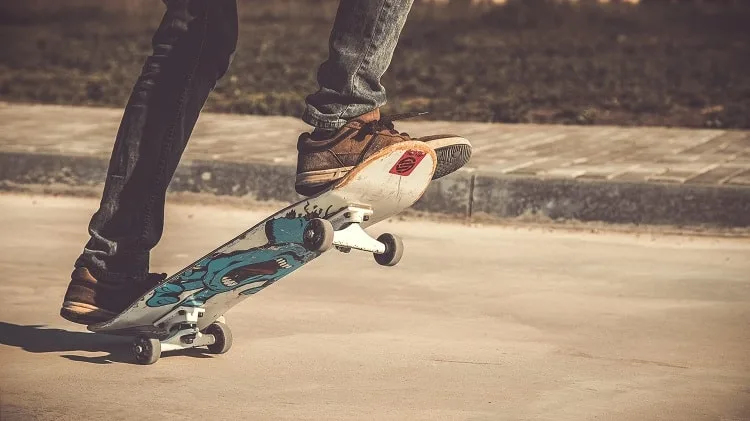
4. Trucks
Skateboard trucks are generally all the same. The only real thing to differentiate them is quality, although some brands are more responsive than others, and they vary slightly in width and height depending on your preferences. The bushings can be changed out for harder or softer options, depending on how much movement or response you want from your skateboard.
Longboard trucks are a lot more complicated than skateboard trucks. There are several different types available depending on your riding style and the deck you choose, and the options can quickly become confusing. Here are some of the more commonly available options:
- Top mount trucks. Top mounts are similar to skateboard trucks in that they attach to the bottom of the deck and sit right underneath your feet, offering a lot of control and stability. These are the most common type, especially for shorter boards.
- Drop through trucks. Another common type, drop through trucks are attached from the side via cut-outs in the deck, offering a ton of stability but less control.
- Drop deck trucks. Drop deck trucks are top-mounted but the point to where they are attached is higher than the board itself. This style gives you a lower center of gravity and thus more control at high speeds. These are the trucks commonly used by pros and speed freaks.
5. Wheels
Skateboard wheels come in a wide variety of shapes, sizes, and durometers (hardness). For street skating, you typically want a wheel size of between 50 and 60mm. These wheels are small and light and thus ideal for performing tricks.
If you skate a lot of transition or bowls, however, you’ll want something slightly bigger. You’ll also want wheels on the harder end, around 100a. This will give you quick acceleration, but they do not feel great on hills or for long-distance riding.
Longboard wheels are a lot bigger than skateboard wheels because they are built for speed. Even if you just use a longboard for cruising, bigger, softer wheels feel great and will roll over stones and cracks with ease. You’ll want wheels of between 65 and 90mm in size and around 75a — big and soft for speed and comfort.
Which is right for you?
Now that you understand the differences between a skateboard and a longboard, you may still be wondering which option is best for you. The most important question you need to ask when deciding between the two is: what do you need it for?
Skateboarding and longboarding are both drastically different in their purpose, and so you need to decide which one feels right to you. Of course, you can always change your mind at a later stage.
If you are keen to cruise the streets at a leisurely pace and are not into performing many tricks, a longboard is likely the right choice for you. The same can be said for commuting and transport, learning to skate, and of course, flying downhills.
However, if you want to learn tricks, skate on ramps and bowls, and ride around a skatepark, a skateboard is definitely the right choice.
Skateboards Pros
- Small and lightweight
- Comparatively inexpensive
- Perfect for tricks
- Adaptable
- Fewer shapes and sizes to worry about
Skateboards Cons
- Unstable at high speeds
- Not as long-lasting
- More difficult to learn on
Longboards Pros
- Easy to learn on
- Smooth riding experience
- A large variety of shapes available
- Fast
- Stable
Longboards Cons
- Limited uses
- No kicks
- Limited trick capability
Our favorite skateboards
Whether you’ve decided that a skateboard or a longboard is the right choice for you, we highly recommend going with a full setup. This will eliminate the confusion at the beginning of choosing a deck, trucks, wheels, etc, and give you a complete board setup that is ready to ride.
Once you are comfortable on your board, you can begin to focus on the exact specifics of the components of your board and start experimenting with different wheel sizes, deck sizes, etc.
Powell Golden Dragon Complete – Our top choice overall
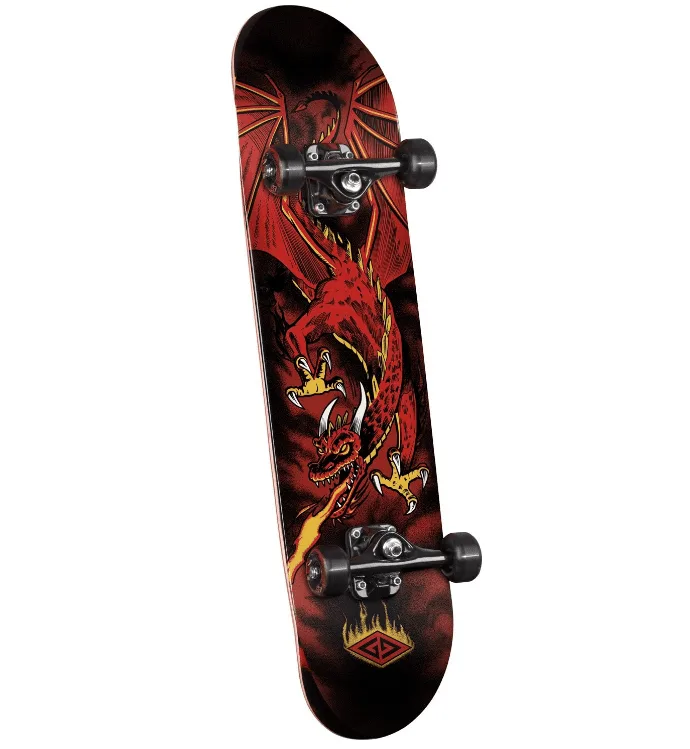
If you are looking for a high-quality complete skateboard with long-lasting components from a trusted company in the industry, look no further than the Golden Dragon complete from Powell Peralta.
This complete setup has a 7.5-inch maple deck, Powell Peralta aluminum trucks, and medium durometer 54mm Powell wheels, ideal for beginners looking to jump into the world of street skating, from a trusted brand that has been in the industry almost from street seatings inception.
CCS Complete skateboard – Best on a budget
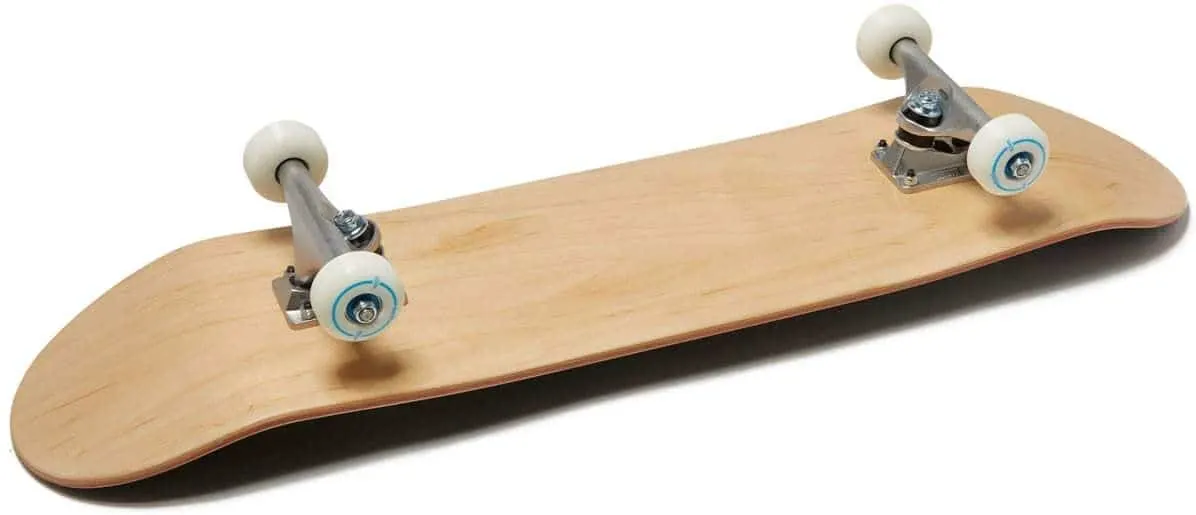
If you are looking for a decent complete setup that can still provide all you need to hit the streets but need something lighter on your pocket, the CCS complete is great choice. It features a maple CCS logo deck, 52mm, 100a wheels, standard aluminum trucks, and super-fast ABEC-7 bearings.
CCS make high-quality boards that are aimed at beginners looking to get into the sport without breaking the bank, and as a beginner, you will not be disappointed with this setup! Plus, you get a free skate tool!
Our favorite longboards
Santa Cruz Screaming hand longboard – Our top choice overall

This drop-down longboard from the iconic skate brand Santa Cruz features a 40-inch drop-down deck, reverse kingpin black aluminum trucks, 70mm wheels, and the classic “screaming hand” logo that is a staple of the Santa Cruz brand.
If you are looking for high quality and long-lasting board to bomb hills with, this full setup from Sant Cruz is an ideal choice!
Minority Downhill maple – Best on a budget
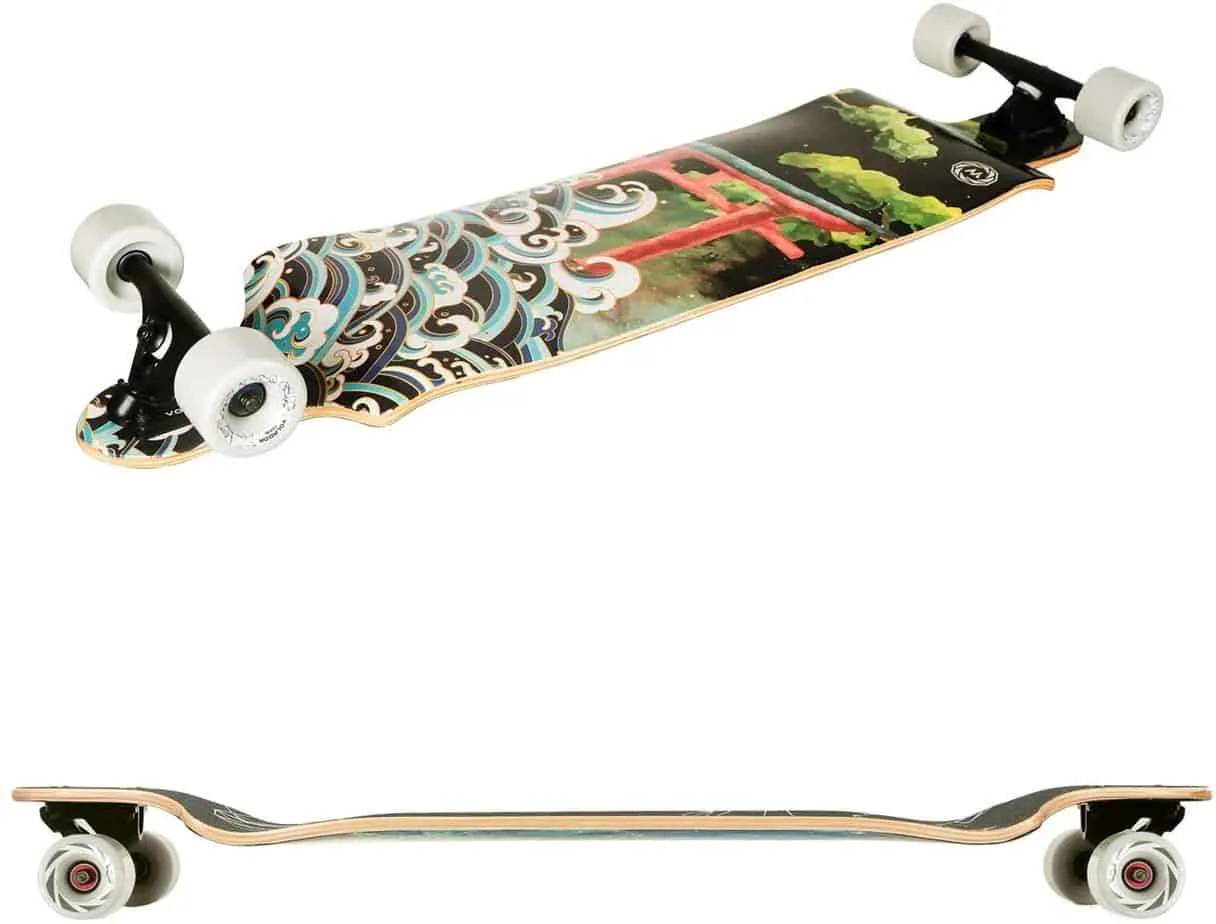
Minority makes some of the best skateboards and longboards for budget-conscious skaters, and this drop-deck full setup is no different.
Featuring an 8-ply, 100% maple deck, 7-inch reverse kingpin, adjustable trucks, and 70mm wheels loaded with ABEC-9 bearings, it doesn’t get much better value for money than this. Plus, the boards come with a range of incredible graphic options!
Still confused?
If both these options sound great to you and you are still stuck on deciding which to choose, there is one other option available. Maybe you love the idea of bombing hills on a stable board with larger wheels, but also are attracted to the ability to hop up and down curbs, ride in pools and bowls, and maybe even pop a kickflip every now and then, but don’t want to fork out the cash for two different boards. In this case, the hybrid board is the ideal option!
Hybrid board are about the size of a skateboard, but wider and sometimes longer, with larger wheels and a flatter, more stable, bi-directional deck design. They typically have a wide tail with a kick, a mild concave, and even a slightly curved nose.
These boards are great for cruising while still capable of performing basic tricks and are a great option if you want the best of both worlds. For city cruising and commuting, there is arguably a no better option than a good quality cruiser. Check out the Magneto Mini Cruiser for the ultimate hybrid experience.
Common Questions and Answers
Answer: In terms of purchasing a quality board, longboards are definitely more expensive than skateboards. While you can get cheap versions of both, for a decent quality longboard complete you are looking at upwards of $300. A decent complete skateboard, on the other hand, will only cost around $100.
Bear in mind that with a skateboard, you are jumping around on it and throwing it downstairs, and they usually take quite a beating. For this reason, longboards last a great deal longer than skateboards, and so are actually cheaper in the long run. Your longboard can last for decades if looked after properly, whereas a skateboard will last 6 months to a year at most if you are doing a ton of tricks.
Answer: Considering the fact that longboarding generally only involves cruising down hills, albeit often at high speeds, it is definitely easier to learn. Also, the large wheels and stability of the board make it far easier for beginners. Skateboarding involves a lot of technical ability which can take quite a while to master. Even the ollie, the very first trick you should learn, can take years to properly master.
Answer: While speeding down hills may not sound very safe, you can choose the size of the hill you want to bomb or even just be content with cruising on flat streets, and so longboarding is definitely safer overall. Longboards are also highly stable and easy to ride, making them far easier to learn on and far harder to fall
off of!
Skateboarding involves obstacles, ramps, bowls, rails, and tricks in which your feet are leaving the board, making falling not only a possibility but a certain inevitability — in skateboarding it’s not about if you’ll fall, but when. Falling is just a part of the sport. In that sense, longboarding is definitely safer.
Conclusion
While there is a lot more to both skateboards and longboards than this article can cover, we’ve covered all the basic differences between the two styles of boards. This article should give you a good general idea about what each style of board entails and make it easier for you to choose which one you prefer.
Do you simply want to cruise the streets and bomb a few hills now and then, or perhaps use your board for transport? Then a longboard is likely the choice for you. If you’d like to learn some tricks, skate on ramps and bowls, then a skateboard is the way to go. If both these options sound equally tempting, you may want to consider getting a hybrid board.
In any case, both longboarding and skateboarding are a ton of fun, and both are sports we promise you will not regret becoming a part of!

